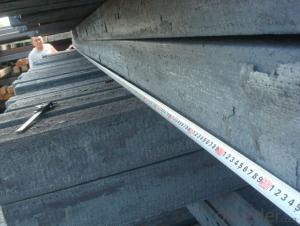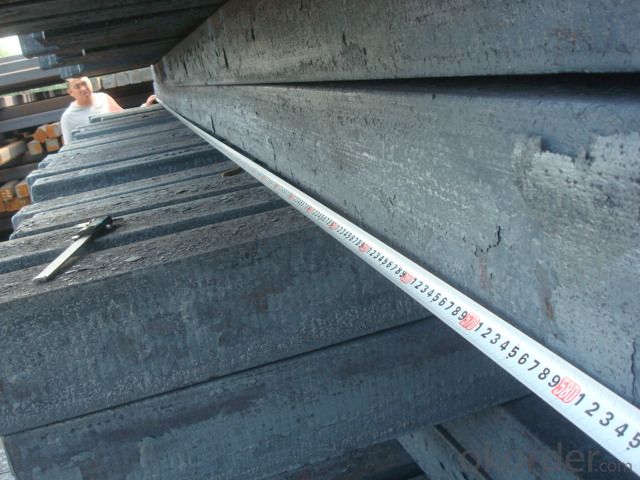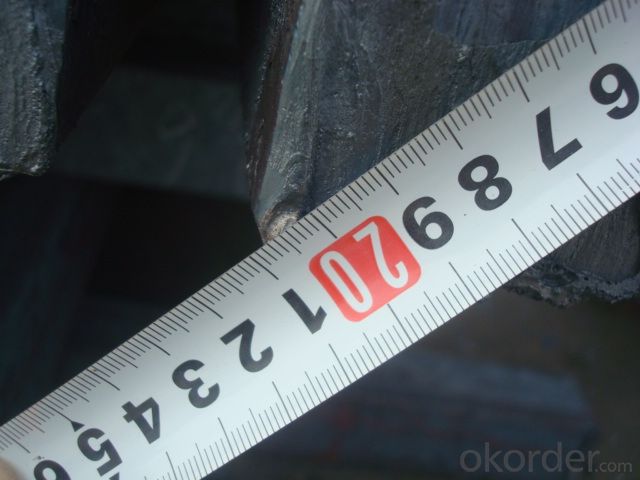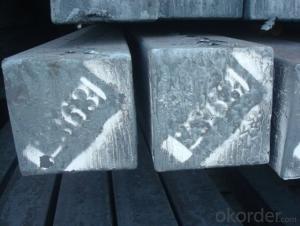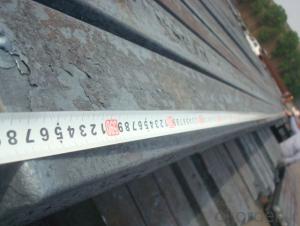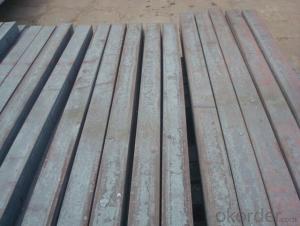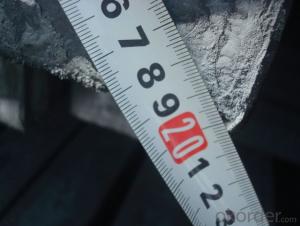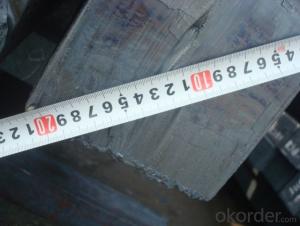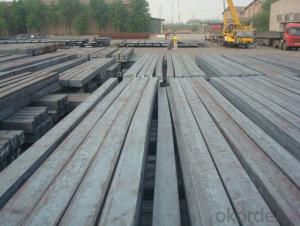Continue Casting Steel Billets/Blooms Manufactured By Blasting Furnace
- Loading Port:
- Qingdao
- Payment Terms:
- TT OR LC
- Min Order Qty:
- 1000 m.t.
- Supply Capability:
- 10000 m.t./month
OKorder Service Pledge
OKorder Financial Service
You Might Also Like
Continue Casting Steel Billets/Blooms Manufactured By Blasting Furnace
1.Structure of Casting Steel Billets/Blooms Manufactured By Blasting Furnace
Continue Casting Steel Billets/Blooms Manufactured By Blasting Furnace is the raw material of all kinds of steel mill. Billet section of square, round, flat, rectangular and abnormity, etc Several, mainly related to shape of rolled products. Simple rolled section steel, choose cross section of square billet or rectangular billet. rolling The sector products such as flat steel, Angle steel, select the rectangular billet or slab. Had better profiled billet when production beams, channels, and in rolling process Lines and improve the yield. The raw material of round billet is the production of seamless tube.
2.Main Features of Continue Casting Steel Billet Manufactured By Blasting Furnace.
Continue Casting Steel Billet Manufactured By Blasting Furnace section size should meet the requirements of rolling deformation and finished product quality, but also roll strength and biting condition of restrictions. General steel Billet section height H. And the roll diameter D The ratio of the ( namely H/D) Should be less than or equal to zero 0.5 . Length of steel billet by finishing temperature, Rolling time and the length of the product Or times ruler. When heated too long accident prone to bump the furnace wall of steel, too short, furnace bottom utilization rate is not high, influence the heating furnace production. For the production Choose a variety of steel and steel billet, should consider the affinities of billet, as far as possible in order to improve the productivity of the roughing mill, simplify the stock management of workshop.
3. Continue Casting Steel Billets/Blooms Manufactured By Blasting Furnace Images
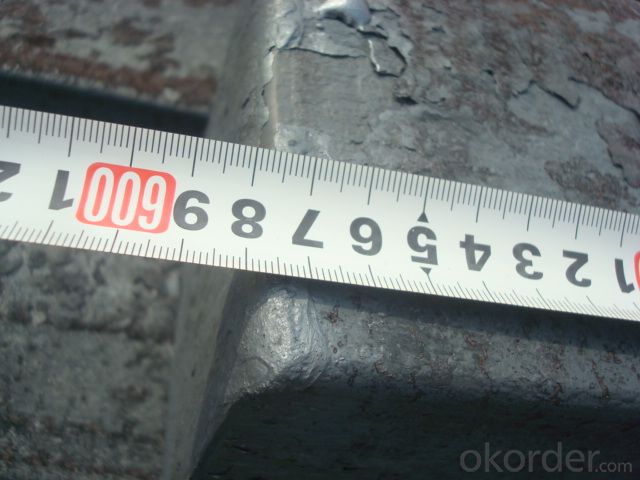
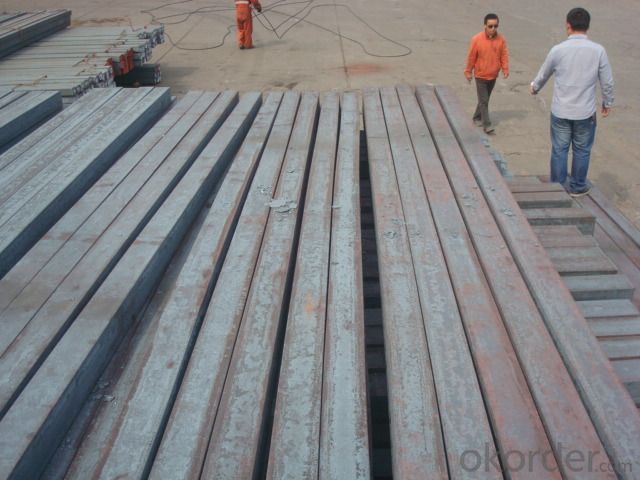
4. Continue Casting Steel Billets/Blooms Manufactured By Blasting Furnace Specification
Continue Casting Steel Billet Manufactured By Blasting Furnace rolled steel, after processing can be used for mechanical parts, forging parts, processing all kinds of steel, steel Q345B channel steel, wire rod is the role of the billet. Steel billet is used in the production of semi-finished products, generally cannot be used directly for the society. Steel billets and steel are strictly divided into standard, cannot decide to whether the business enterprise of the final product, and according to unified standards to perform the whole society. Typically, billet and the steel is relatively easy to distinguish, but for some steel billet, and have the same specification and same steel purposes (such as rolling tube billet), whether can be used for other industries, whether through steel processing process, whether through a finished product rolling mill processing to distinguish
There are three shapes of the steel billets: square billet, slab, rectangular billet The Chinese billet, rectangular billet is mainly suitable for rolling hot rolled strip, building reinforced bar, Ordinary wire, high speed wire rod and various small profile. Of the slab are mainly used for rolling plate and hot coil sheet.
The classification of the steel According to the quality classification (1)Ordinary steel (P 0.045% or less,S 0.050% or less)POn behalf ofphosphorus,s.On behalf ofsulfur Pands.Are all of the steelThe harmful elements, a leading toHot brittleness, a leading toCold brittle (2)High quality steel (P,s.both0.035% or less) (3)High quality steel (P 0.035% or less,S 0.030% or less)
Classified by chemical composition (1)Carbon steel: A.Low carbon steel (C 0.25% or less);Also known asMild steel ,The intensity ofLow,hardnessLow and soft, are often used in the manufacture of chainArticle, Rivet, Bolt, Shaft etc. .It includes most of theOrdinary carbon structural steelAnd part ofHigh quality carbonElement of structural steelMost,Without heat treatmentUsed in engineering structures, some classicscarburizingandOther heat treatmentUsed forrequirementsThe wear resistance of machine parts. B.Medium carbon steel (0.25 C or less 0.60% or less);There areKilled steel,Half killed steel,Rimmed steelWait for a variety of products.Hot working and good cutting performance,Poor welding performance.Plasticity and toughness lower than that of low carbon steel.Can beWithout heatTo deal with, the direct use ofHot rolled material,Cold drawn material, but alsoAfter heat treatmentAfter use.quenching,temperingIn the afterCarbon steel withGood comprehensive mechanical properties.To be able to achieveThe highest hardness is aboutHRC55 (HB538),sigmabfor600~1100 mpa.So in theModerate intensity levelA variety of purposes,Medium carbon steel is the most widelyApplied, in addition to asBuilding materialsOutside, still a lot for makingTo build all kinds of mechanical parts. C.High carbon steel (C 0.60% or higher).Often saidTool steel , you canhardenedandtempering .hammer,crowbarSuch as byCarbon content0.75%The steel manufacturing; Cutting tools such as drill bit,tap,reamerSuch as byCarbon content0.90%to1.00%Made of steel. (2)Alloy steel: A.Low alloy steel (alloy elements in total5% or less) B.Total content in alloy steel (alloy elements> 5 ~ 10%) C.High alloy steel (alloy elements in total> 10%).
5.FAQ of Continue Casting Steel Billets/Blooms Manufactured By Blasting Furnace
We have organized several common questions for our clients,may help you sincerely:
①How about your company?
A world class manufacturer & supplier of castings forging in carbon steel and alloy steel,is one of the large-scale professional investment casting production bases in China,consisting of both casting foundry forging and machining factory. Annually more than 8000 tons Precision casting and forging parts are exported to markets in Europe,America and Japan. OEM casting and forging service available according to customer’s requirements.
②How to guarantee the quality of the products?
We have established the international advanced quality management system,every link from raw material to final product we have strict quality test;We resolutely put an end to unqualified products flowing into the market. At the same time, we will provide necessary follow-up service assurance.
③How is the packaging and delivery?
Loose by Vessel and the delivery term is based on the the quantity and our factory’s schedule then.
- Q: How do steel billets contribute to the marine industry?
- The marine industry relies heavily on steel billets, which serve a crucial role in constructing and maintaining marine structures and vessels. These semi-finished steel products offer numerous benefits and are widely used in the marine industry. First and foremost, steel billets possess excellent strength properties and are highly durable. This makes them ideal for withstanding harsh marine conditions like corrosion, extreme temperatures, and high-pressure environments. They are commonly used in building ship hulls, offshore platforms, and other marine structures that face the challenging conditions of the sea. Additionally, steel billets can be easily shaped and molded into various forms, making them versatile for a wide range of marine applications. They can be used to produce different components and parts such as propeller shafts, engine components, pipelines, and structural beams. Moreover, steel billets are vital in manufacturing anchors, chains, and other mooring equipment crucial for securing vessels and offshore structures. Furthermore, steel billets are known for their excellent weldability, which is essential in the marine industry. Regular maintenance, repair, and modification are common requirements for ships and offshore structures. The seamless welding of steel billets allows for efficient repairs and alterations, ensuring the structural integrity and safety of marine vessels and infrastructure. In terms of sustainability, steel billets have a long lifespan and can be recycled multiple times. This makes them an environmentally friendly choice for the marine industry, reducing the need for new raw materials and minimizing environmental impact. To summarize, steel billets are indispensable to the marine industry due to their durability, strength, versatility, weldability, and sustainability. Their qualities enable their use in constructing, repairing, and maintaining marine structures and vessels, ensuring their reliability and longevity in the challenging marine environment.
- Q: How do steel billets contribute to the manufacturing of marine gear?
- Steel billets contribute to the manufacturing of marine gear by serving as the raw material for the production of various components, such as gears, shafts, and bearings. These billets are first heated and then shaped through forging or machining processes to create the desired gear components with high strength and durability. The use of steel billets ensures that the marine gear can withstand the harsh conditions of marine environments, such as corrosion, high loads, and extreme temperatures, ultimately enhancing the performance and reliability of the gear in marine applications.
- Q: What are the main challenges in the quality control of steel billets?
- Several factors can affect the quality and performance of steel billets, posing significant challenges in their quality control. Here, we outline some key obstacles in this regard: 1. Chemical Composition: The accurate chemical composition of steel billets is pivotal in determining their strength, durability, and mechanical properties. However, ensuring consistent chemical composition is challenging due to variations in raw materials, melting processes, and the presence of impurities. 2. Homogeneity: It is crucial to achieve uniformity in the microstructure and composition throughout the steel billet. Inadequate mixing or non-uniform cooling can lead to inconsistencies, resulting in weak areas and uneven mechanical properties. 3. Defect Detection: Detecting and eliminating defects in steel billets is essential to prevent failures during subsequent processing and usage. Common defects include cracks, inclusions, segregation, porosity, and surface irregularities. However, accurately and promptly detecting these defects can be challenging due to their size, complexity, and location. 4. Dimensional Accuracy: Consistency in the dimensions and shape of steel billets is vital for their further processing and use in various applications. Maintaining precise dimensions requires controlling variables such as casting speed, cooling rates, and mold design. 5. Surface Quality: The condition of the surface of steel billets is critical for subsequent operations like rolling, forging, or machining. Ensuring a smooth, clean, and defect-free surface is challenging due to factors such as scale formation, oxidation, decarburization, and surface contamination during handling and storage. 6. Heat Treatment: Proper heat treatment is often necessary to achieve the desired mechanical properties in steel billets. However, controlling the heating and cooling rates, as well as the soaking times, can be challenging due to variations in equipment, temperature monitoring, and quenching techniques. 7. Traceability: Maintaining traceability and documentation throughout the production process is crucial for quality control. Tracking the origin of raw materials, process parameters, testing records, and certifications can be challenging, especially in complex supply chains. To address these challenges in the quality control of steel billets, a combination of advanced testing techniques, robust process controls, skilled personnel, and continuous improvement initiatives is necessary.
- Q: What are the different types of steel billet casting methods?
- There are several different methods used for steel billet casting, each with its own advantages and applications. The most commonly used methods include continuous casting, static casting, and centrifugal casting. 1. Continuous Casting: This is the most widely used method for steel billet casting. In this process, molten steel is poured into a water-cooled mold, where it solidifies into a continuous strand. The strand is then cut into desired lengths by a cutting machine. Continuous casting allows for high production rates and consistent quality, making it ideal for mass production of steel billets. 2. Static Casting: Also known as ingot casting, this method involves pouring molten steel into a stationary mold, where it solidifies into a solid billet. The mold is typically made of sand or metal, and the solidification process can be controlled to obtain desired properties. Static casting is often used for smaller production runs or when specific alloy compositions or shapes are required. 3. Centrifugal Casting: This method utilizes centrifugal force to distribute molten steel evenly within a rotating mold. As the mold spins, the molten steel is pushed towards the mold walls, resulting in a uniform casting with improved density and mechanical properties. Centrifugal casting is commonly used for large and complex billets, such as those used in pipe manufacturing or turbine components. These are the main methods used for steel billet casting; however, there may be variations or combinations of these methods depending on specific requirements or technological advancements.
- Q: How are steel billets transported internationally?
- Depending on factors such as distance, quantity, and urgency, steel billets are transported internationally by various means. Popular methods include shipping, rail, and road transportation. For long-distance international transport, shipping is the preferred choice. Steel billets are loaded into shipping containers, typically 20-foot or 40-foot in size, and secured to prevent movement during transit. These containers are then transported by cargo ships, which offer large storage capacities and efficient transportation over vast distances. Designed to protect the steel billets from external elements like moisture and corrosion, shipping containers ensure their integrity upon arrival. Rail transport is also commonly used for international shipments, especially to destinations connected by rail networks. Steel billets are loaded onto railcars, either in open-top or covered wagons depending on requirements and weather conditions. Rail transportation is favored for its cost-effectiveness, ability to handle large volumes, and access to landlocked regions. For shorter distances or urgent deliveries, road transportation is employed. Steel billets are loaded onto flatbed trucks or trailers, securely fastened to prevent any movement, and transported directly to their destination. Road transport offers flexibility, allowing delivery to locations where other modes may face limitations. Regardless of the transportation mode, international shipments of steel billets must have proper documentation, including customs clearance, bill of lading, and other relevant paperwork. These ensure compliance with international trade regulations, smooth border crossings, and timely delivery of the steel billets to their destination.
- Q: Is the reaction of carbon and carbon dioxide a redox reaction?
- The reaction of carbon and carbon dioxide is redox reaction.Turn left and turn right |Oxidation reduction reaction is a kind of reaction that changes the number of oxidation of elements before and after chemical reaction. The essence of redox reaction is the gain or loss of electrons or the offset of common electron pairs. The oxidation number of the element changes before and after the redox reaction.
- Q: What is the typical composition of a steel billet?
- The specific grade and intended use of a steel billet can cause its typical composition to vary. Nevertheless, in general, a steel billet primarily consists of iron, carbon, and additional alloying elements. Steel's main constituent is iron, which typically accounts for about 98% of its composition. This element provides the material with structural strength and durability. Carbon, the second most significant element, usually ranges from 0.02% to 2.1% and plays a vital role in determining the steel's hardness and strength. Besides iron and carbon, steel billets often incorporate various alloying elements to enhance specific properties. These elements may include manganese, silicon, nickel, chromium, molybdenum, vanadium, and others. Each element contributes to different characteristics, such as corrosion resistance, heat resistance, toughness, or machinability. Moreover, steel billets are frequently produced through processes like continuous casting or hot rolling, which can introduce small amounts of impurities. These impurities, such as sulfur, phosphorus, and oxygen, are typically maintained at very low levels to preserve the desired quality of the steel. In conclusion, the typical composition of a steel billet comprises a combination of iron, carbon, alloying elements, and minor impurities. These components are carefully regulated to achieve the desired mechanical properties and performance for a wide range of applications in industries such as construction, automotive, aerospace, and manufacturing.
- Q: What are the different types of mechanical property testing methods for steel billets?
- Some different types of mechanical property testing methods for steel billets include tensile testing, hardness testing, impact testing, and fatigue testing. Tensile testing measures the strength and ductility of the material by applying a pulling force until it breaks. Hardness testing measures the resistance of the material to penetration or indentation. Impact testing evaluates the material's ability to absorb energy under high rates of loading. Fatigue testing assesses the material's resistance to failure under cyclic loading conditions.
- Q: How are steel billets used in the manufacturing of railway components?
- Steel billets are an essential raw material used in the manufacturing of railway components. These billets serve as the starting point for the production of various components such as rails, wheels, axles, and other structural parts. To begin with, steel billets are heated in a furnace to a specific temperature to make them more malleable and easier to shape. Once heated, the billets are then passed through a series of rolling mills, where they are progressively shaped into the desired form. For instance, to manufacture railway tracks, the heated billets are rolled and shaped into long continuous bars of steel known as rails. These rails are then cut to the required length and undergo further processes such as straightening, grinding, and drilling to meet the necessary specifications. Similarly, steel billets are also used in the manufacturing of railway wheels and axles. The heated billets are rolled and shaped into round bars, which are then further processed to form the wheel and axle components. These components undergo additional processes such as heat treatment, machining, and testing to ensure their strength, durability, and ability to withstand the heavy loads and stresses associated with railway operations. Furthermore, steel billets are utilized in the production of other railway components such as couplers, buffers, and suspension systems. These billets are shaped and processed according to the specific requirements of each component to ensure their proper functioning and compatibility with the overall railway system. In summary, steel billets are a critical ingredient in the manufacturing of railway components. They are transformed through heating and rolling processes to create various parts such as rails, wheels, axles, and other structural elements. These components are then further processed and tested to ensure their quality, reliability, and compliance with the demanding standards of the railway industry.
- Q: What are the potential applications of steel billets in the aerospace aftermarket?
- Steel billets have a wide range of potential applications in the aerospace aftermarket. These applications include but are not limited to the production of various aerospace components such as engine parts, airframe structures, landing gear components, and fasteners. One potential application of steel billets in the aerospace aftermarket is the manufacturing of engine parts. Steel billets can be used to produce critical components such as turbine blades, compressor discs, and shafts. These parts require high strength, durability, and resistance to extreme temperatures, all of which can be achieved through the use of steel billets. Additionally, steel billets can be used to produce exhaust system components, such as manifolds and flanges, which also require high temperature resistance. Another important application of steel billets in the aerospace aftermarket is in the production of airframe structures. Steel billets can be utilized to manufacture various structural components, including beams, frames, and brackets. These components are crucial for providing strength and stability to the aircraft's fuselage, wings, and other structural elements. Steel billets offer the necessary strength-to-weight ratio, corrosion resistance, and fatigue resistance required for these demanding applications. Furthermore, steel billets can be used to produce landing gear components in the aerospace aftermarket. Landing gear plays a critical role in the safe operation of an aircraft, and it must withstand significant loads and stresses during takeoff, landing, and taxiing. Steel billets can be machined into landing gear parts such as axles, struts, and wheels, which require high strength, toughness, and fatigue resistance. Lastly, steel billets find applications in the production of fasteners used in the aerospace aftermarket. Fasteners such as bolts, screws, and nuts are essential for joining various components together in an aircraft. Steel billets can be forged or machined into high-strength fasteners that can withstand the high loads and vibrations experienced during flight. In summary, steel billets have numerous potential applications in the aerospace aftermarket. From engine parts to airframe structures, landing gear components, and fasteners, steel billets provide the necessary properties required for the demanding aerospace industry, including strength, durability, temperature resistance, and fatigue resistance.
Send your message to us
Continue Casting Steel Billets/Blooms Manufactured By Blasting Furnace
- Loading Port:
- Qingdao
- Payment Terms:
- TT OR LC
- Min Order Qty:
- 1000 m.t.
- Supply Capability:
- 10000 m.t./month
OKorder Service Pledge
OKorder Financial Service
Similar products
Hot products
Hot Searches
Related keywords
